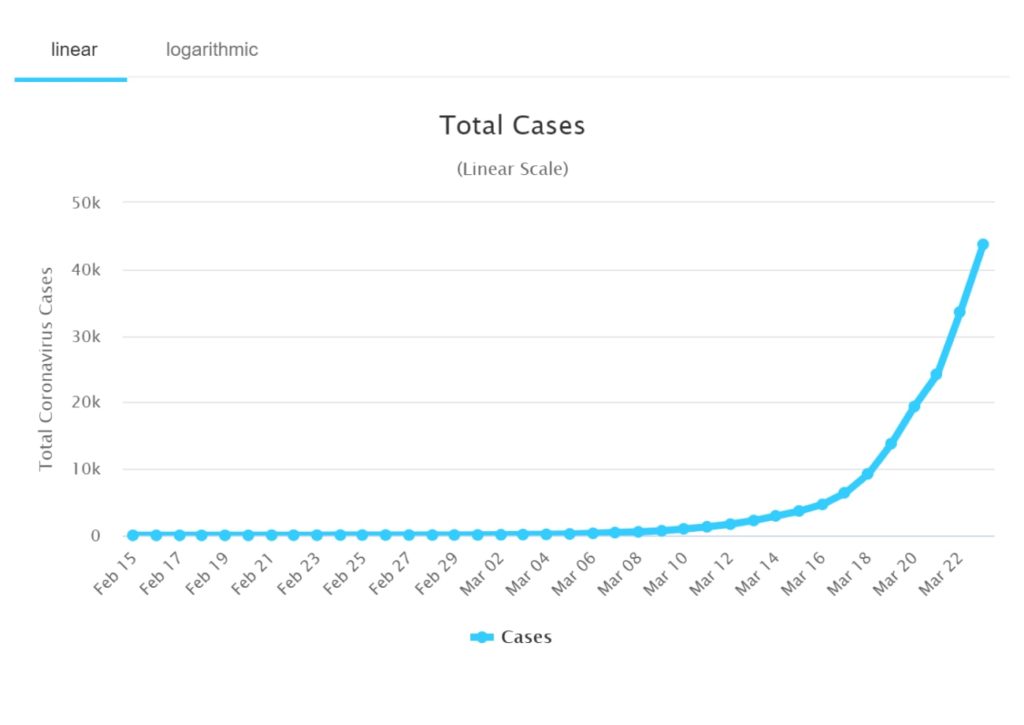Impact of corona virus on elearning & distance learning solutions development
COVID-19 Coronavirus is causing a huge demand in eLearning solutions development throughout the world, and Distributed Hub is ready to step in and help you if you need one.
Force-majeure events, including storms, earthquakes, floods and the spread of viral diseases create serious barriers for traditional classroom education, leading to extra expenses for schools, colleges and universities trying to contain and resolve the situation. At the moment, the COVID-19 coronavirus is the culprit, wreaking havoc and causing disruption for both students and educators alike.
COVID-19 Recent Stats
The Coronavirus pandemic has spread throughout the world. There are already over 30,000 cases in the US alone, with new cases and deaths numbers rising in every state.

The rise of new COVID-19 coronavirus cases in the US. Source
The Effect of the COVID-19 Coronavirus on Education Around the World
The new COVID-19 coronavirus has already left its footprint in almost every corner of our world. At the time of writing, 46 US states have shut down schools, two states had schools closed for the whole academic year, and some other states had districts where most of the schools were closed or scheduled to be closed. This amounts to 56 million students missing school in the US alone.

US School closures due to coronavirus outbreak. Source
According to UNESCO, due to the coronavirus hazard, over 100 countries have closed down schools and universities nationwide, sending over half the world’s students home.

School closures due to coronavirus worldwide. Source
Under these heavy circumstances, many schools have already turned to eLearning solutions to effectively provide distance learning and remotely manage their students’ performance. For instance, in the US, Frisco ISD district teachers started giving digital lessons from March 17. They’ve done this by incorporating Google Classroom and a number of other eLearning platforms into their remote classwork. As we see it, many other states and districts will soon follow this practice to continue providing education to students at home using advanced capabilities of eLearning solutions.
According to pre-pandemic statistics, the global eLearning solutions market is expected to grow from $15.72 billion in 2021 to $22.4 billion in 2023. We think that, in light of recent events and the spike of the vicious COVID-19 coronavirus, these numbers are to be even higher.
All this plays into the inevitable fact that all schools and universities will soon have to provide services using distance learning solutions with an adaptive, convenient UI/UX, and all the schooling and training capabilities ingrained within a mobile-first approach and built-in accessibility.
eLearning and Distance Learning Solutions for Schools, Colleges and Universities
Schools, colleges, and universities require a whole framework of eLearning tools to effectively convey knowledge to students online. Learning Management Systems or LMS are a compilation of all the tools needed to cater to the educational requirements of schools from K-12 to the university level.
The must-have and most common features of these eLearning solutions include but are not limited to:
- Virtual classrooms with video conferencing
- Digital coursework and course creation
- Online quizzes and testing
- Gamification and interactive lessons
- Student work upload and assessment
- Grade overviews with a reporting dashboard
- Mobile-oriented learning and multi-device support
- ADA accessibility features to accommodate all students.
The LMS offer sophisticated tutoring tools and insightful analytics powered by such disruptive technologies as AI and Big Data. These tools allow students to learn at a pace that’s convenient for them while also helping teachers automate processes and communicate with students via video calls, chats and comments on student’s performance.
It is known that eLearning solutions have a much higher retention rate of 25% to 60%, compared to retention rates of conventional classroom studying at only 8-10%. Integrating a powerful LMS distance learning solution into your school’s IT infrastructure will surely have a positive impact on your students’ success and your school’s academic rankings.
This advantage over conventional education is achieved through a student-centric approach where students are plunged into an environment with enhanced collaboration, communication and gamification that engages them to learn and share their results, ultimately creating a social-networking experience. At the same time, teachers are provided a solution that streamlines educational content creation and enables customization of lessons based on the student’s capability and performance monitored by the learning management system. It also offers them attendance monitoring, dynamic grading, an overview dashboard, and much more.
Need a learning management system like this in place at your educational institution? Reach out to us and we’ll provide you with a customized eLearning and distance learning solution.
Top eLearning Solutions Features to Look Out For
Below is the list of the most crucial features of distance learning and eLearning solutions that make the educational process streamlined, fast-paced and efficient:
- Custom course design: easily create and customize courses enriched with all types of content: text, visual and audio. Distance learning solutions allow you to embed content from third-party tools such as YouTube, Google Drive, Atlas, eduCanon, Evernote or any other web content tool.
- Personalized lessons: identify the students’ learning capability, their needs and interests, and create the perfect learning curve with individualized guides, instructions and problems to solve using the seamless UI of distance learning solutions.
- Advanced grading and annotation tools: easily access the students’ work and track their assignment experience by viewing the problem-solving process live. Seeing the whole picture, provide valuable feedback with text or video comments, record grades and share the students’ performance with their peers.
- Student performance monitoring: track your students’ performance against educational standards, your own academic objectives, and the performance of your whole district. Having this insightful data stored, organized, and visualized into a graphic dashboard with the help of your distance learning solution, make mindful decisions on how to improve on your students’ results.
- Refined student data analytics: use insightful analytics of distance learning solutions designed to drag out key student performance indicators out of the pool of big data to the surface, and dynamically tune the learning experience using state-of-the-art AI technology.
- Student and class profiles: Make use of generated and aggregated data on the whole class and each and every individual student in their profile, presented via a user-friendly and convenient interface. See which students are struggling, what they are struggling with, and whether they fit in the current peer group. Make well-informed decisions and create the best environment for students to succeed.
- Social-networking experience: your LMS should be designed in the way students like to get by outside of class. The UI and UX should be intuitive, with seamless interactions and the ability to share learning experience and provide feedback via images, audio messages and videos.
- Open and accessible knowledge base: the eLearning solution must have a digital library available to students without boundaries and limitations. A universal knowledge base also stores the resources required by teachers, including user-generated lessons and assignments, study plans, student profiles, etc. This data is categorized, filtered and sorted to provide easy access.
- Messenger & notifications: Enable open communication between teachers, the faculty, students, their parents and other parties involved in the educational process using a messenger built into the LMS. Use notifications to provide updates and deliver the latest news to all users of your eLearning solution.
- Full package of integrations: Drag all of your tools, apps, and other external SCORM-compliant content into one distance learning solution, and create the ultimate teaching & learning environment for your school.
- Sophisticated API to enable scalability: Your LMS needs an open API to allow developers build custom eLearning solutions for your environment and further expand the platform’s capabilities.
Create the Perfect Online Learning Experience
The COVID-19 coronavirus is seriously impeding education around the world, causing millions of students to miss classes while schools bear additional expenses to counter the situation. It is time for you to fight back. Modern eLearning solutions such as Learning Management Systems offer a plethora of tools to efficiently manage the distance learning process.
There are plenty of eLearning and distance learning solutions available on the market, however, all of them have their limitations and none of them offer the full package of features described in this article. If you need to create the perfect online learning experience for your students, turn to an experienced software development company to provide you with distance learning solutions development tailored specifically for your educational institution.
